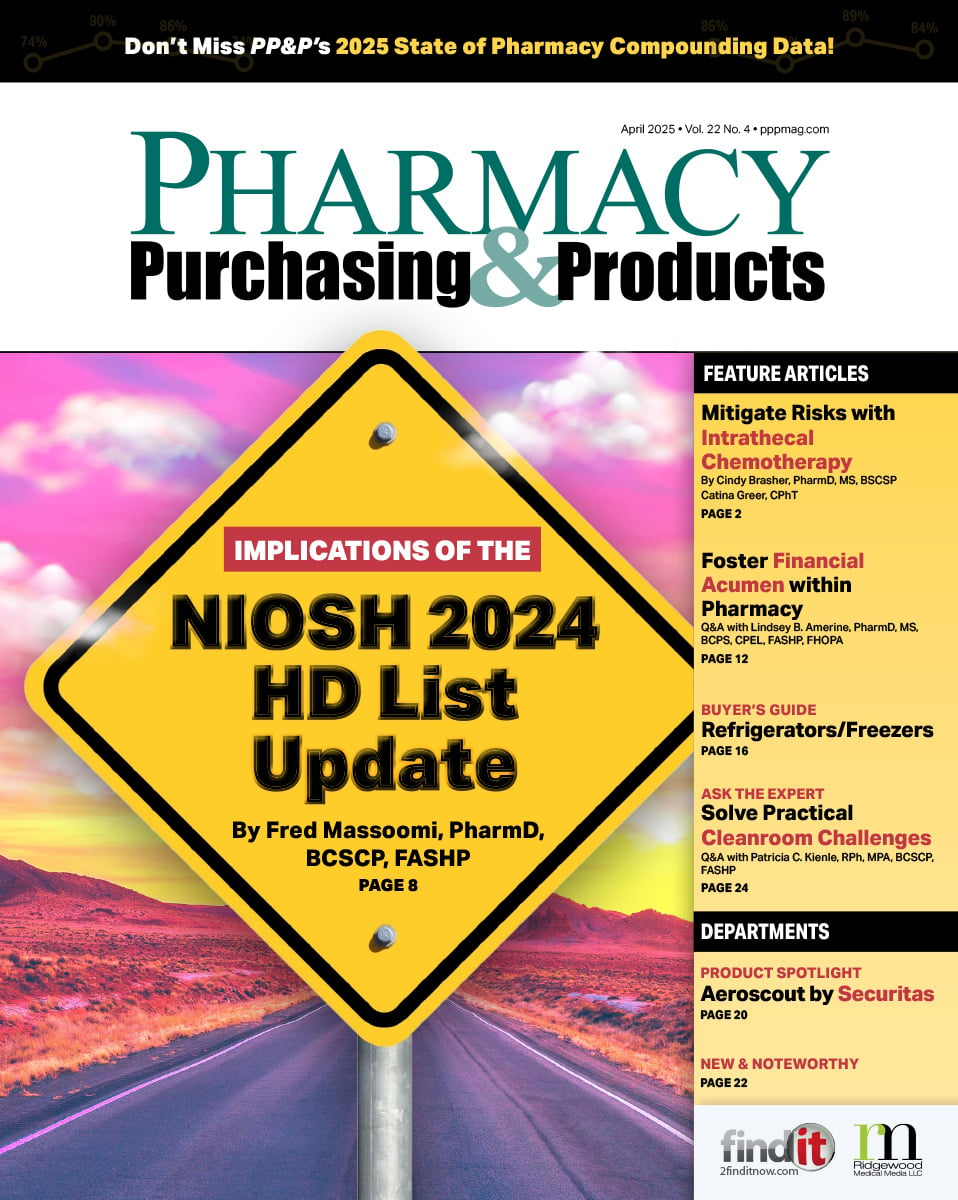- Show Menu
- Contact Us
- FAQs
- Reader Service
- Survey Data
- Survey Winners
- Testimonials
- Upcoming Events
- Webinars
- White Papers
USP <800> Compliance in Outpatient Infusion Clinics
Q&A with Vannessa Berrios, RPh;
Dominique Smith, PharmD; and
Jeffrey S. Reichard, PharmD, MS, BCPS
Pharmacy Purchasing & Products: How has USP <800> been received at your health system?
Berrios, Smith, and Reichard: The overall response to USP <800> has been positive. Many of our team members see the value in the chapter as a positive change designed to protect health care workers and patients from potentially hazardous substances. In fact, some of our most experienced pharmacists and nurses question why these hazardous drug (HD) handling changes were not implemented long ago, as health care workers have been handling these drugs for many years.
It is critical that all team members have a clear understanding of why USP <800> is necessary. To start, it is important to emphasize that safe HD handling is not a new topic. The Occupational Safety and Health Association (OSHA) first published guidelines for the management of cytotoxic drugs in the workplace in 1986, and the American Society of Hospital Pharmacists published its revised technical assistance bulletin on handling cytotoxic and HDs in 1990; however, no regulatory agency has enforced these guidelines. USP <800> standards, like USP <797>, are enforceable by state boards of pharmacies as of December 1, 2019, and The Joint Commission and CMS expect full compliance with USP standards, which are considered best practice. Now is the perfect moment to use this information to gain staff buy-in for practice change.
PP&P: How did your organization identify USP <800> compliance concerns?
Berrios, Smith, and Reichard: USP <800> allows organizations to perform an assessment of risk (AoR) to identify suitable handling requirements for HDs used within the health system. We performed an AoR for all HDs on our health system’s formulary. This assessment is driving many changes around receiving, storing, manipulating/compounding, and labeling HDs. In addition, we conducted a gap analysis to identify additional changes that would be required to become USP <800>-compliant. As a result, we revised our training and cleaning procedures, and we are working to standardize processes and staff training.
Our gap analysis and AoR process identified the following specific USP <800>-compliance concerns:
- Identifying hazardous substances within our inventory management software and CPOE system. To ensure HD identification, we compared our formulary database and CPOE medication build data with the 2016 NIOSH list to create an organization-specific HD list. Drugs that are not included in the NIOSH list, but that have similar mechanisms of action to other known HDs, are considered HDs
- Developing a handling strategy for the non-antineoplastic HDs included in Groups 2 and 3 of the NIOSH list, such warfarin and oxytocin. Containment strategies may include purchasing premixed products from 503B outsourcing facilities; purchasing oral, unit dose products; dispensing finished dosage forms in a sealable bag; and ensuring clear labeling during storage and dispensing that includes handling, administration, and disposal precautions
- Implementing P&Ps for antineoplastic HD receiving and decontamination
- Ensuring proper storage of antineoplastic HDs
- Use of appropriate personal protective equipment (PPE) and compliant cleaning procedures
- Proper use of primary and secondary engineering controls, as well as compliant closed system drug-transfer device (CSTD) use for preparation and administration of all HDs used in the organization
PP&P: What are some of the most common USP <800>-compliance issues that facilities face?
Berrios, Smith, and Reichard: For many organizations, typical compliance challenges include facility updates, ensuring appropriate HD storage, adopting CSTDs and proper PPE, as well as ensuring compliant cleanroom cleaning, training documentation, and waste requirements.
- Compliant Facilities. Many organizations will need facility upgrades to ensure compliance with USP <800> requirements. Our health system, Novant Health, is fortunate that many of our facilities require only minimal updates to achieve compliance with the structural requirements of the chapter.
- Drug Storage Requirements. Adequate storage space in pharmacy areas is a common challenge. We noticed that some small clinics had one refrigerator for storing both non-HD and antineoplastic HDs (eg, IVIG stored in the refrigerator located in the negative pressure buffer room). In these cases, we installed a refrigerator for non-antineoplastic HDs in the positive pressure buffer room (or anteroom area) to segregate inventory from antineoplastic HDs.
- CSTD Use. USP <800> requires the use of CSTDs during HD administration and recommends CSTD use during drug preparation. CSTDs have been employed consistently for 5 years in our outpatient clinics and 10 years in our acute care spaces. However, while evaluating our current HD administration practice, it became clear that some practices were inconsistent. One area for improvement concerned the use of CSTDs for intramuscular injections or bladder instillations. These situations present an opportunity to define standard practice across the health system, as well as to determine which procedure should be considered best practice. We are still evaluating with our nursing partners the safest alternatives for administering intramuscular injections and bladder instillations using a CSTD. Revising administration practices and ensuring compliance with policies and procedures (P&Ps) often requires a multidisciplinary approach, with perspectives from pharmacy, nursing, and administration. The collaboration of a multidisciplinary team of pharmacy and nursing members has been extremely valuable during the evaluation of current practices and possible solutions to ensure safe HD handling.
- PPE. Novant Health uses chemotherapy-rated gloves when handling all medications. However, to become compliant with USP <800>, seamless gowns must be worn during HD manipulation. We are working with our supplier to ensure availability of this product.
- Cleaning. Proper cleaning requires careful evaluation of cleaning and disinfecting agents for effectiveness, compatibility, and safe use. Pharmacy developed relationships with the Environmental Services and Infection Prevention departments to evaluate the agents we are currently using to decontaminate and disinfect our facilities, and has determined that our cleaning agents are USP-compliant. It is important to note that the care setting may dictate who performs the various aspects of cleaning required by USP <800>, which necessitates comprehensive education and training for all employees performing cleaning services (eg, housekeeping, contract service employees, etc).
- Waste Requirements. Novant Health disposes of all hazardous pharmaceutical waste according to local, state, and federal regulations. Waste is segregated in different containers as dual waste (pharmaceutical waste with attached sharps, which is most commonly generated in nursing areas), bulk waste (pharmaceutical waste without sharps, generated in pharmacy), and trace waste (supplies used to make antineoplastic products, including empty syringes and empty vials, as well as PPE used to make and administer antineoplastic products). A pharmaceutical waste disposal company picks up waste containers for destruction.
PP&P: How should an organization assess the risk of staff and patient HD exposure in outpatient infusion clinics?
Berrios, Smith, and Reichard: A clear understanding of the level of HD exposure is critical to implementing strategies to protect staff and patients. Novant Health utilizes wipe sampling and a medical surveillance program to assess the risk of HD contamination in our facilities.
Environmental wipe sampling is performed every 6 months in high-exposure/high-risk areas within the pharmacy and in the infusion centers, including the sterile compounding areas where drugs are manipulated, the receiving areas, and the medication administration area (ie, infusion chair, floor, or IV pump). Utilizing surface wipe testing allows us to validate that our cleaning procedures are properly decontaminating the areas that have the highest potential exposure to HDs. Patients receiving chemotherapy endure the most significant HD exposure, and it is important to have validated decontamination procedures in place to ensure a safe environment for the next patient in that treatment area.
A medical surveillance program is in place to monitor the health and safety of team members preparing and administering hazardous medications. USP <800> has prompted us to re-evaluate the scope of this program to include other team members who may be exposed to HD residue but were not previously monitored, such as environmental services personnel and pharmacy team members who receive HDs into the facility.
PP&P: How can <800> be leveraged within an organization to address space and budget constraints?
Berrios, Smith, and Reichard: Health systems should place a strong emphasis on USP compliance and staff safety, and understand the link between regulatory compliance and ensuring excellent patient care. While the required facilities changes can be costly, a commitment to compliance is a commitment to best practice. If hospital administration is hesitant to assign the necessary resources to compliance efforts, pharmacy should emphasize that USP <797> and USP <800> compliance will be mandatory within the CMS Conditions of Participation. Engage administration as soon as possible, as many of the required facilities changes will necessitate a significant time and capital commitment.
PP&P: What policies are necessary to guide spill management in outpatient infusion clinics?
Berrios, Smith, and Reichard: An HD spill management policy addressing the management of powder and liquid drug spills is in place throughout Novant Health. Each area that administers chemotherapy has a chemotherapy spill kit on-hand. In preparation for USP <800>, we plan to implement a supplemental kit as well, as some of the commercially available spill kits do not include all of the tools necessary to completely clean up a spill. The supplemental kit will include an agent to remove HD residue (ie, a hydrogen peroxide and peroxyacetic acid product), an EPA-registered germicidal detergent to clean the area after decontamination (ie, a hydrogen peroxide or quaternary ammonium product), a bottle of water, one extra pair of shoe covers, chemo gloves and a chemo gown, and extra towels or absorbent pads. Pharmacy will provide additional education regarding how to use the supplemental spill kits, and assess staff competency.
PP&P: What efforts can pharmacy make to ensure staff training and education is effective?
Berrios, Smith, and Reichard: Pharmacy is currently evaluating which USP <800> topics require training and education. Our health system plans to implement a combination of methods, including written tools, computer-based learning modules, and hands-on training. Evaluation of the available computer-based learning modules is ongoing. Training will encompass all disciplines that come into contact with HDs, including (but not limited to) pharmacy, nursing, and environmental services. Each discipline is responsible for its own training, although pharmacy has served as the system lead for many of the USP <800> training and education initiatives. All staff training decisions are managed throughout the health system by a shared partnership among pharmacy, nursing, environmental services, and regulatory stakeholders to ensure consistency across all sites.
Pharmacy, nursing, and environmental services leadership was engaged early on to ensure successful completion of USP training and competency assessments. In addition, engaging frontline team members has been crucial to success.
PP&P: What is the most critical issue to address in the quest for USP <800> compliance?
Berrios, Smith, and Reichard: For most health systems, transforming the organization’s culture concerning safe HD handling will be the linchpin of their efforts to ensure compliance with USP <800>. Dedicating one individual exclusively to managing the USP <800>-compliance project has been exceptionally helpful in this regard at Novant Health. We are lucky to employ a regulatory specialist who focuses 100% of her time on USP compliance. This work supports team members in multiple areas of the hospital, including pharmacy, nursing, administration, and environmental services. Administration’s significant commitment to safety and compliance has strengthened our organization’s overall culture of safety.

Vannessa M. Berrios, RPh, is the pharmacy regulatory specialist of USP for Novant Health. She graduated from the University of Puerto Rico School of Pharmacy in 1994 and is an active member of ASHP.

Dominique Smith, PharmD, is a PGY1 pharmacy resident at Novant Health Forsyth Medical Center, a 961-bed community hospital located in Winston-Salem, North Carolina. She received her Doctor of Pharmacy degree from the Virginia Commonwealth University School of Pharmacy in Richmond, Virginia.

Jeffrey S. Reichard, PharmD, MS, BCPS, is the director of pharmacy for infusion, oncology, and specialty pharmacy service lines at Novant Health. He received his Doctorate of Pharmacy degree from the University of North Carolina at Chapel Hill Eshelman School of Pharmacy.
Like what you've read? Please log in or create a free account to enjoy more of what www.pppmag.com has to offer.








